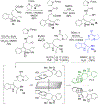Fungal indole alkaloid biogenesis through evolution of a bifunctional reductase/Diels-Alderase
- PMID: 31548667
- PMCID: PMC6815239
- DOI: 10.1038/s41557-019-0326-6
Fungal indole alkaloid biogenesis through evolution of a bifunctional reductase/Diels-Alderase
Abstract
Prenylated indole alkaloids such as the calmodulin-inhibitory malbrancheamides and anthelmintic paraherquamides possess great structural diversity and pharmaceutical utility. Here, we report complete elucidation of the malbrancheamide biosynthetic pathway accomplished through complementary approaches. These include a biomimetic total synthesis to access the natural alkaloid and biosynthetic intermediates in racemic form and in vitro enzymatic reconstitution to provide access to the natural antipode (+)-malbrancheamide. Reductive cleavage of an L-Pro-L-Trp dipeptide from the MalG non-ribosomal peptide synthetase (NRPS) followed by reverse prenylation and a cascade of post-NRPS reactions culminates in an intramolecular [4+2] hetero-Diels-Alder (IMDA) cyclization to furnish the bicyclo[2.2.2]diazaoctane scaffold. Enzymatic assembly of optically pure (+)-premalbrancheamide involves an unexpected zwitterionic intermediate where MalC catalyses enantioselective cycloaddition as a bifunctional NADPH-dependent reductase/Diels-Alderase. The crystal structures of substrate and product complexes together with site-directed mutagenesis and molecular dynamics simulations demonstrate how MalC and PhqE (its homologue from the paraherquamide pathway) catalyse diastereo- and enantioselective cyclization in the construction of this important class of secondary metabolites.
Conflict of interest statement
Figures





References
-
- Robertson AP et al. Paraherquamide and 2-deoxy-paraherquamide distinguish cholinergic receptor subtypes in ascaris muscle. J Pharmacol Exp Ther 303, 853–860 (2002). - PubMed
-
- Little PR et al. Efficacy of a combined oral formulation of derquantel-abamectin against the adult and larval stages of nematodes in sheep, including anthelmintic-resistant strains. Vet Parasitol 181, 180–193 (2011). - PubMed
Publication types
MeSH terms
Substances
Grants and funding
LinkOut - more resources
Full Text Sources
Other Literature Sources
Molecular Biology Databases

